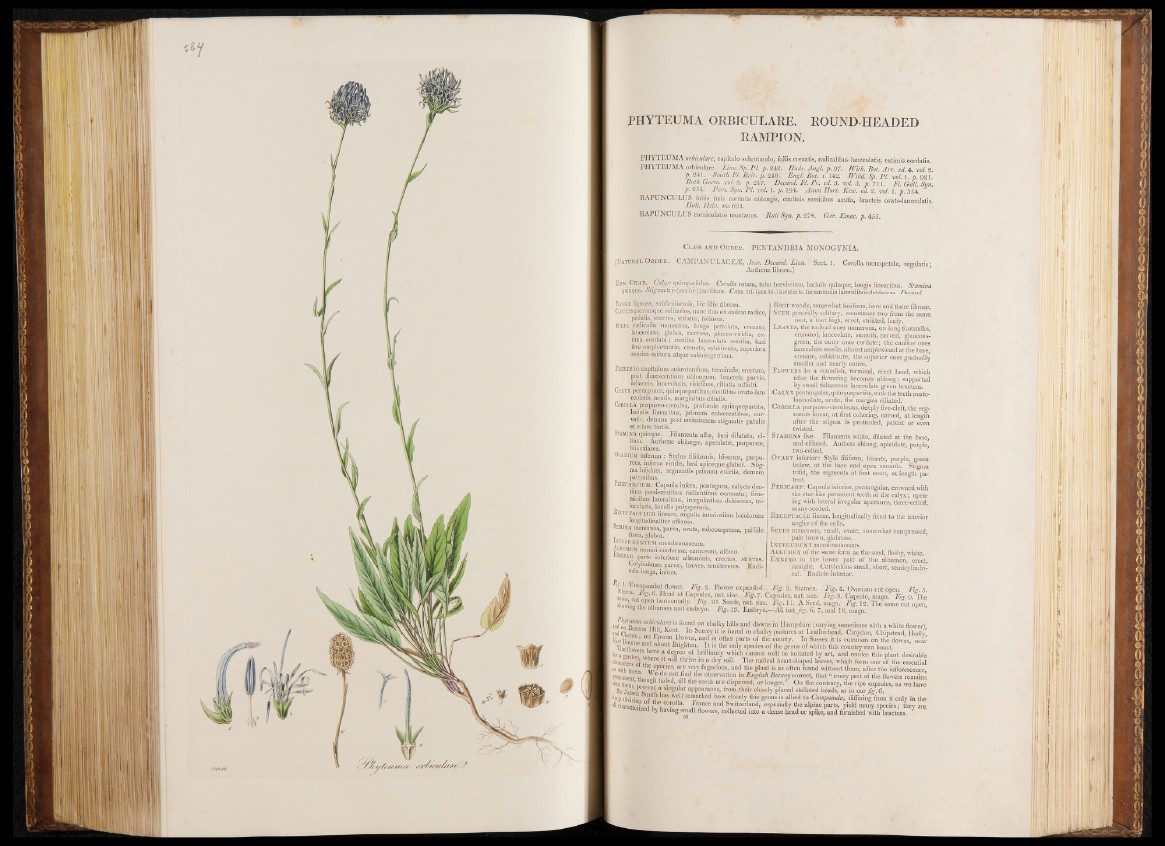
PHYTEUMA ORBICULARE. ROUND-HEADED
RAMPION.
PHYTEUMA orbiculare, capitulo subrotundo, foliis crenatis, radicalibus lanceolatis, extimis cordatis.
PHYTEUMA orbiculare. Linn. Sp. PI. p. 242. Huds. Angl. p . 97. With. Bot. Arr. cd. 4. ml. 2.
p . 241. Smith Fl. Brit. p. 240. Engl. Bot. 1. 142. Willd. Sp. P i. ml. 1. p . 921.
Roth Germ. m l. 2 . p . 247. Decand. F lF r . ed. 3. ml. 3. p . 711. Fl. Gall. Syn.
p . 254. Pers. Syn. P i. ml. 1 . p . 194. Alton Hort. Kero ed. 2. ml. 1 . p . 354.
RAPUNCULUS foliis imis cordatis oblongis, caulinis sessilibus acutis, bracteis ovato-lanceolatis.
Hall. Helm no. 6 3 l l § |||
RAPUNCULUS corniculatus montanus. Rail Syn. p. 278. Ger. Emac. p . 455.
Class a n d Order; PENTANDRIA MONOGYNIA.
[Natural Ord e r . CAMPANULACE.ZE, Juss. Decand. Linn. Sect. 1 . Corolla monopetala, regularis;
Anther® liber®.]
Gen. Char. Calyx quinquefidus. Corolla rotata, tubo brevissimo, laciniis quinque, longis linearibus. Stamina
quinque. Stigma tn- (seu bi-) partitum. Caps, tri- (seu bi-) locularis, foraminulis lateralibus dehiscens. Decand.
Radix lignosa, subfusiformis, hie illic fibrosa.
Caulis plërumque solitarius, nunc duo ex eadem radice,
pedalisj erectus,' striatus, foliosus.
Folia radicalia numerosa, longe petiolata, crenata
lanceolata, glabra, nervosa, glauco-viridia, ex-
fima corda ta ; caulina lanceolata sessilia, basi
fere amplectantia, crenata, subhirsuta, superiora
sensim minora atque subintegerrima.
Flores in capitulum subrotundum, terminale, erectum,
post fldrescentiam oblongum, bracteis. parvis*
foliàceis, lanceolatis, viridibus, ciliatis suffulti. * 1
Calyx pentagonus, quinquepartitus, deutibus ovato-lan-
j ceolatis, acutis, marginibus ciliatis.
Corolla purpureo-cærulea, profunde quinquepartita,
laciniis linearibus, primum cohærentibus, cur-,
vatis, demum post emissionem stigmatis patulis
et etianï tortis.
Stamina quinque. Filamenta alba, basi dilatata, citato
Anther® oblong®, apiculat®, purpure®,
biloculares.
Ovarium inferum : Stylus filiformis, hirsutus, purpu-
reus, inferne viridis, basi apieeque glaber. .Stigma
bifidum, segmentis primum erectis, demum
patentibus.
Pericarpium: Capsula inféra, pentagona, calycis deh-
tibus persistentibus radiantibus coronata; fora-
minibus lateralibus, irregularibus dehiscens, tri-
locularis', loculis polyspermis.
Keceptaculum lineare, angulis interioribus loculorum
• longitudinaliter affixum.
EMina numerosa, parva, ovata, subcompressa, pallide
fusea, glabra.
Integumentum membranaceum.
Albumen semini conforme, carnosum, album.
BRYO parte inferiore albuminis, erectus, strictus.
Cotyledones parv®, breves, semiteretes. Radi-
Gula longa,inféra.
Root woody, somewhat fusiform, here and there fibrose.
Stem generally solitary, sometimes two from the same
root, a foot high, erect, striated, leafy.
Leaves, the radical ones numerous, on long footstalks,
crenated, lanceolate, smooth, nerved, glaucous-
green, the outer ones cordage; the cauline ones
lanceolate sessile, almost amplexicaul at the base,
crenate, subhirsute, the superior ones gradually
smaller and nearly entire.
Flowers in a roundish, terminal, erect head, which
after the flowering becomes qblong; supported
by small foliaceous lanceolate green bracteas.
Calyx pentangular, quinquepartite, with the teeth ovato-
lanceolate, acute, the margins ciliated.
Corolla purpureo-c®ruleous, deeply five-cleft, the segments
linear, at first cohering, curved, at length
after the stigma is protruded, patent or even
twisted.
Stamens five. Filaments white, dilated at the base,
and ciliated. Anthers oblong, apiculate, purple,
two-celled.
Ovary inferior: Style filiform, hirsute, purple, green
below, at the base and apex smooth. Stigma
trifid, the segments at first erect, at length patent.
Pe r ic a r p :. Capsule inferior, pentangular, crowned with
the star-like persistent teeth of the calyx; opening
with lateral irregular apertures, three-celled,
many-seeded.
Receptacle linear, longitudinally fixed to the interior
angles of the cells.
Seeds numerous, small, ovate, somewhat compressed,
pale brown, glabrous.
I ntegument membranaceous.
Albumen of the same form as the seed, fleshy, white.
E mbryo in the lower part o f the albumen, erect,
straight. Cotyledons small, short, semicylindri-
cal. Radicle inferior.
\ e m ne£ nKeHfl0r r; f . i?^ ',2' Ho™r expanded. Fig. 3. Stamen. Fig. 4. Ovarium cut open. Fig. 5.
sum*. /!, * ' ^Pad ol Capsules, nat. size. Fig. 7. Capsules, nat. size. Fig. 8. Capsule, magn. Fis. 9. The
showin^1tePMhh0nZ°nt1 ly' ill 10U.Seeds’ "a t size- F ig .ll. A Seed, magn. Fig. 1 2 . The^ame cut open, «owing the albumen and embryo. Fig. 13. Embryo.— All but fig . 6, 7, and 10, magn.
and on Beacon n - u v Is found on chalky lulls and downs in Hampshire (varying sometimes with a white flower),
and Clieam H Ken£ In 111S found ,n chalky pastures at Leatherhead, Croydon, Chipstead, Hedly,
East Bourne »!!i Lf S0"1J >.°^ ns> anTd “ other parts of the county. In Sussex it is common on the downs, near
The flowm. i a )0Uj Bn§hton* 13 the only species of the genus, of which this country can boast,
for a garden S H I ?! dfl ref Pf brilliancy which cannot well be imitated by art, and render this plant desirable
characters nf | , leie thnve “ a dl7 SQl1- The radical heart-shaped leaves, which form one o f the essential
as with them w Pe.C‘eS’ ar,e ^ry fugacious, and the plant is as often found without them, after the inflorescence,
permanent thmmhfnl! f f i s ® the ° j Servati,?n m English Botany correct, that “ every part o f the flowers remains
seen them ’urgent- m l j i f t ie seeds are dispersed, or longer.” On the contrary, the ripe capsules, as we have
Sir Jamee Sln§u ar aPPearance> from their closely placed stellated heads, as in our fig. 6.
\ deep division a '“ S I re™arked how closely this genus is allied to Campanula, differing from it only in the
all character! u \ G - - , , ance and Switzerland, especially the alpine parts, yield many species: they are
y having small flowers, collected into a dense head or spike, and furnished with bracteas.